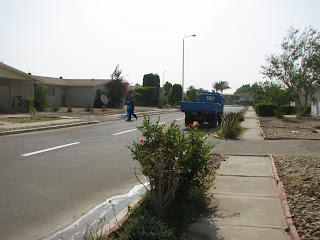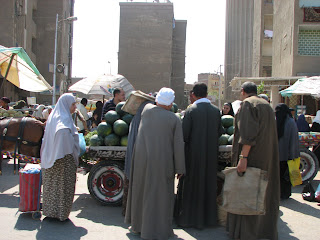I couldn't figure out another O word associated with Lebanese. :) Anyway, we were up in Cairo for the evening and I had a PLAN. Said plan only included Ottoman Empire and Lebanese; Omar was a surprise. :)
The American Research Center in Egypt is a nonprofit founded to support research on all aspects of Egyptian history and culture. It partners with the Egyptian Supreme Council of Antiquities on major conservation projects and it provides a weekly lecture on Wednesdays for the general public. This week's lecture was entitled "The Ottoman Revolution, the Egyptian Press, and the Struggle over Islamic Politics" and I thought, "Hey, we know next to nothing about that....let's go!" We had the desk attendant at the crash pad write the address carefully in Arabic (David's team shares a very nice apartment building, aka the crash pad, in Cairo with other TAFT teams around Egypt for when they're in the city for any reason. They are HUGE apartments with a TV, pool table, computers, plus they have guards that watch the cars. These guards have guns which look like Uzis which makes me a bit nervous..but they're very nice) . The taxi driver seemed to know where to go and we were off to the Garden City district (actually right next to the Embassy). Dropped us off at the wrong building (my fault) and we were given subsequent directions from a security-type person that the building (2 Simon Bolivar Ave) was down a block, to our left. The problem is that none of the buildings had numbers as far as we could tell. As we were walking down the street, hoping for a sign, we ran into three men, sitting on chairs watching the busy traffic go by.
"What are you looking for?" one man asked.
We told him and he replied "Oh, that's right here", pointing behind him to a building which did not look like what I expected. It was rundown, no sign or number; it didn't even look like the front of the building, just an open side door. I must have looked skeptical because he asked "What? You don't believe me? I'm here all day. I should know. The ARCE office is on the second floor." He then introduced himself as Omar and, on finding out David was with the Army, told us about his uncle who works with the Egyptian military and the US military in some capacity. He implored us to go to his neighboring shop to see the certificate of recognition his uncle had received from the US Army and to please have some tea with him. So we went to his shop and looked around but told him we couldn't stay since we wanted to attend that lecture. He made us promise, PROMISE, to come back for tea after the lecture. We promised.
He was absolutely right about the ARCE office on the second floor. The lecture was about one of the debates held in the Moslem world in the early 20th century regarding whether or not it was appropriate to depose the Sultan according to Islamic law. I'm sure the University of Florida professor gave enough of an introductory framework for the other professors present, but I apparently needed a much bigger picture as I was mentally scrambling from word one. The Young Turk revolt of 1908? The deposition of Sultan Hamid?? She rattled over names of 19th c. Arab philosophers quickly, not even explaining who they were because they were so "well-known", in order to get to her main topic. David and I regrouped afterwards, trying to pool together what we understood from what she said, and decided to go have some tea with Omar. I actually find it a bit thrilling to hear about a whole world of scholarship about which I know virtually nothing....it's as if looking through a peephole into the garden on the other side of the fence.
Omar very happily greeted us and took us back to his shop which had a bit of everything for those interested in tacky souvenirs. Tin plates etched with the pyramids, papyrus sheets designed with hieroglyphics, glass perfume bottles of all shapes and sizes, as well as large glass containers of perfumes and oils. He asked us to sit and wanted to know if we'd like mint with our tea and then barked orders to his underling, a silent young man who when not getting our tea just sat and watched us. Egyptians seem to be very conscious of their stature, what they should and shouldn't be doing. Omar is the owner of the shop so he would not be the one to actually prepare our tea. We noticed this in our diving class as well. When the instructor wanted to show us something with the oxygen tank, he'd yell something at his subordinate in the other room who'd come in and pick up the oxygen tank and put it on the table. He'd then wait for Magdy to tell him to take it off the table. I remember thinking "Why doesn't he just pick it up himself??" but we've seen this quite a bit in different scenarios.
After we were served tea, Omar told us about the area, his family's history of owning these shops, why his English is so good (working with the Embassy folks), Obama's visit the week before (we've had lots of discussions about Obama since the Speech :) Very likable guy....even when he eventually tried to sell us stuff. To make a long story just a little shorter, we walked out with two large bottles of peppermint and lemon oil....for my virtually nonexistent back problems....and a couple hundred pounds lighter in the pocket. (about $30) David and I are not good at this sort of thing. :) I know bartering is a sort of game, but it's still based on deceptive interactions and I'd rather just trust what people say. I still liked Omar though. We'll most likely visit him again next time we're in his part of town, but we'll be more forceful next time. :)
Next was dinner. A Lebanese restaurant called Sabaya a few blocks away. A Lebanese meal starts out with little dishes, called mezze, which you eat with pita-like bread. We ordered hummus, a smoked eggplant spread, and a roasted vegetable salad. Then we had a grilled meat dish as the entree; David had chicken and I had lamb and beef. When we couldn't eat anymore, our waiter Gamil said "No problem" and brought back this amazing garlic sauce to eat our meat and bread with, as if we were simply tired of the dishes we had ordered! We ate a bit more and then when we absolutely couldn't eat anymore he brought out White coffee which is hot water with orange blossom water and is supposed to calm your stomach. After drinking that, we ate a bit more until we really couldn't eat another bite. It was a slow night so Gamil talked with us for quite a while, gently corrected my Arabic, wanted to know our impressions of Obama's speech, talked about how he had served Jimmy Carter back in the day and then somehow encouraged us to split a baklava and have coffee. It was a wonderful dinner but I'm not sure I've ever felt so full. The next day, still feeling the effects, we had some tuna on Ritz crackers for lunch and a salad for dinner!











































